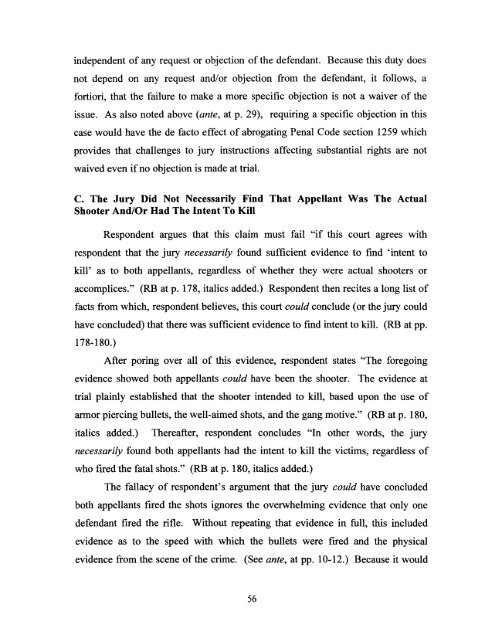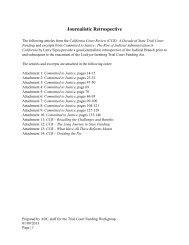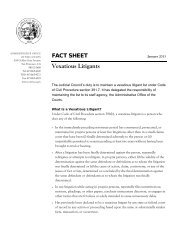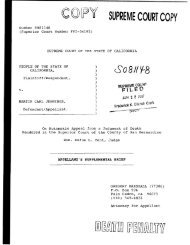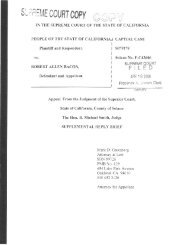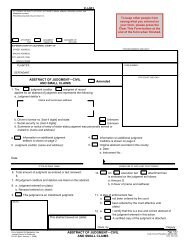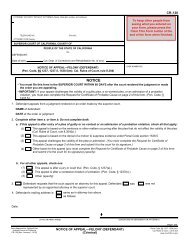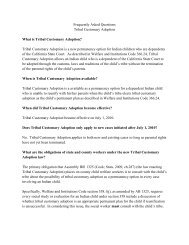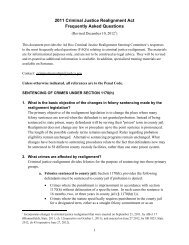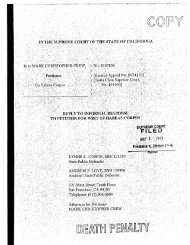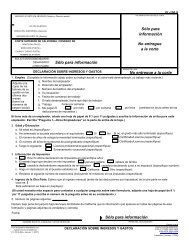Appellant, William Satele, Reply Brief - California Courts - State of ...
Appellant, William Satele, Reply Brief - California Courts - State of ...
Appellant, William Satele, Reply Brief - California Courts - State of ...
You also want an ePaper? Increase the reach of your titles
YUMPU automatically turns print PDFs into web optimized ePapers that Google loves.
independent <strong>of</strong> any request or objection <strong>of</strong>the defendant. Because this duty does<br />
not depend on any request and/or objection from the defendant, it follows, a<br />
fortiori, that the failure to make a more specific objection is not a waiver <strong>of</strong> the<br />
issue. As also noted above (ante, at p. 29), requiring a specific objection in this<br />
case would have the de facto effect <strong>of</strong> abrogating Penal Code section 1259 which<br />
provides that challenges to jury instructions affecting substantial rights are not<br />
waived even ifno objection is made at trial.<br />
C. The Jury Did Not Necessarily Find That <strong>Appellant</strong> Was The Actual<br />
Shooter And/Or Had The Intent To Kill<br />
Respondent argues that this claim must fail "if this court agrees with<br />
respondent that the jury necessarily found sufficient evidence to find 'intent to<br />
kill' as to both appellants, regardless <strong>of</strong> whether they were actual shooters or<br />
accomplices." (RB at p. 178, italics added.) Respondent then recites a long list <strong>of</strong><br />
facts from which, respondent believes, this court could conclude (or the jury could<br />
have concluded) that there was sufficient evidence to fmd intent to kill. (RB at pp.<br />
178-180.)<br />
After poring over all <strong>of</strong> this evidence, respondent states "The foregoing<br />
evidence showed both appellants could have been the shooter. The evidence at<br />
trial plainly established that the shooter intended to kill, based upon the use <strong>of</strong><br />
armor piercing bullets, the well-aimed shots, and the gang motive." (RB at p. 180,<br />
italics added.) Thereafter, respondent concludes "In other words, the jury<br />
necessarily found both appellants had the intent to kill the victims, regardless <strong>of</strong><br />
who frred the fatal shots." (RB at p. 180, italics added.)<br />
The fallacy <strong>of</strong> respondent's argument that the jury could have concluded<br />
both appellants fired the shots ignores the overwhelming evidence that only one<br />
defendant fired the rifle. Without repeating that evidence in full, this included<br />
evidence as to the speed with which the bullets were fired and the physical<br />
evidence from the scene <strong>of</strong>the crime. (See ante, at pp. 10-12.) Because it would<br />
56


